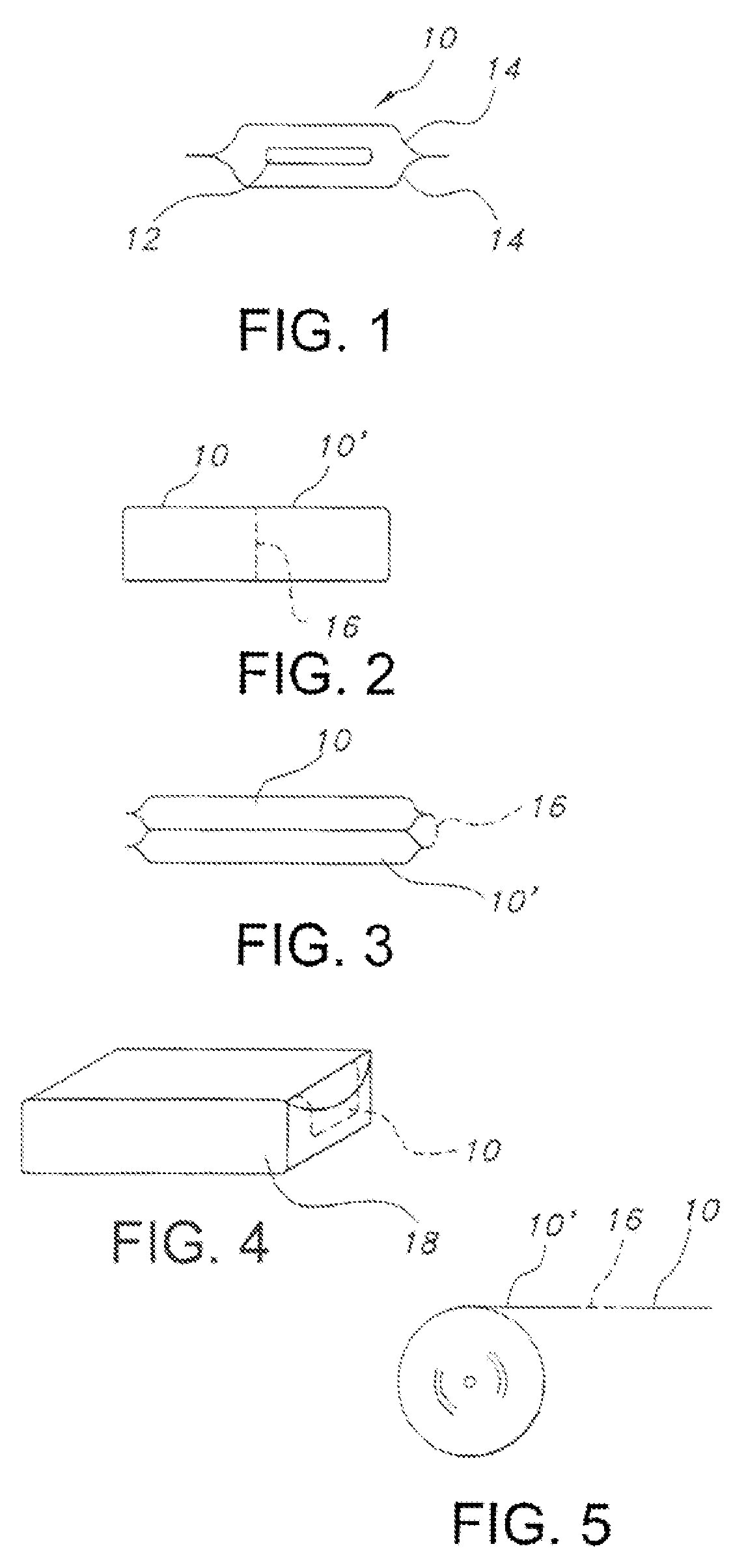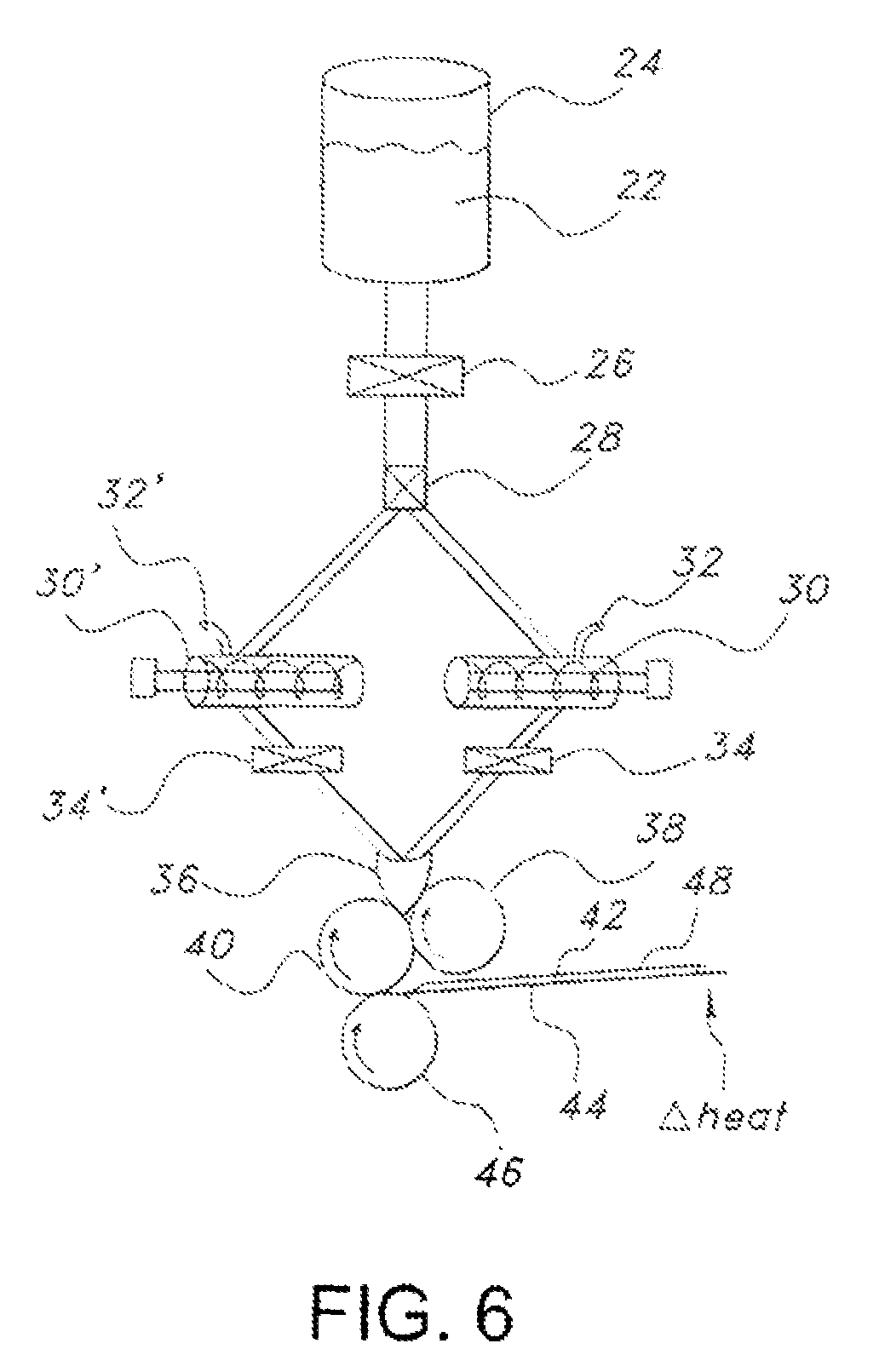Edible water-soluble film containing a foam reducing flavoring agent
a flavoring agent and foam reduction technology, applied in the field of edible water-soluble films, can solve the problems of large difference in the amount of active per film, inability to achieve a high degree of accuracy with respect to the amount of active ingredient in the cut film, and inherently non-uniformity
- Summary
- Abstract
- Description
- Claims
- Application Information
AI Technical Summary
Benefits of technology
Problems solved by technology
Method used
Image
Examples
example 1
[0197]Water-soluble film compositions were prepared using the components set forth in Table 1. The use of low levels of flavors as defoamers in the water-soluble film compositions was evaluated.
[0198]
TABLE 1ComponentNumberAmountWeight %Component1.24.47 g 21.96%Polyethylene oxide2.13.73 g 10.98%Hydroxypropyl methylcellulose(15 cps)3.18.50 g 14.79%Polydextrose4.3.13 g 2.5%Sucralose15.0.63 g 0.5%Mono-ammoniumglycyrrhizinate26.1.25 g 1%Sodium bicarbonate7.2.28 g 1.82%Magnesium stearate8.0.63 g 0.5%Hydrophilic titanium dioxide9.232.31 g Distilled water1Commercially available from McNeil Nutrition2Commercially available as Magna Sweet 100 from Mafco Worldwide Corp.
[0199]Components 8 and 9 were placed in a Degussa 1300 bowl. The components were then processed as described below using the Degussa Dental Multivac Compact.
[0200]
12 minutesstirring = 500 rpmvac. = 0% 4 minutesstirring = 150 rpmvac. = 0% after added a blend ofingredients 1, 2, 3, 4, 5, 6 & 7 1 minutestirring = 100 rpmvac. = 0%...
example 2
[0211]Water-soluble film compositions were prepared using the components set forth in Table 2. The efficacy of a foam reducing flavoring agent was compared to conventional defoaming agents.
[0212]
TABLE 2ComponentNumberAmountWeight %Component1.27.47 g 21.96%Polyethylene oxide2.13.73 g 10.98%Hydroxypropyl methylcellulose(15 cps)3.18.50 g 14.79%Polydextrose4.3.13 g 2.5%Sucralose ® (McNeilNutritionals)5.0.63 g 0.5%Mono-ammoniumglycyrrhizinate36.1.25 g 1%Sodium bicarbonate7.2.28 g 1.82%Magnesium stearate8.0.63 g 0.5%Hydrophilic titanium dioxide9.232.31 g Distilled Water3Commercially available as Magna Sweet 100 from Mafco Worldwide Corp.
[0213]Ingredients 8 and 9 was placed in a bowl and processed as described below using the Degussa Dental Multivac Compact.
[0214]
8 minutesstirring = 500 rpmvac. = 0% (using A310 impeller)5 minutesstirring = 100 rpmvac. = 0% (using gate impeller)after added a blend of ingredients1, 2, 3, 4, 5, 6 & 7
[0215]The resulting solution was foamy. 20 g of the foamy ...
example 3
[0226]An edible water-soluble film containing dextromethorphan HBr (Dx) as an active ingredient was prepared using 1% cherry flavor as a defoaming agent. (92.3 mg strip contains ˜15 mg Dx) (35% solids) The components used to form the film are set forth in Table 3.
[0227]
TABLE 3ComponentNumberAmountWeight %Component1.3.84 g21.96% Polyethylene oxide2.1.92 g10.98% Hydroxypropyl methylcellulose(15 cps)3.2.59 g14.79Polydextrose4.0.44 g2.5%Sucralose ® (McNeil Nutritionals)5.0.09 g0.5%Mono-ammonium glycyrrhizinate46.0.17 g 1%Sodium bicarbonate7.0.32 g1.82% Magnesium stearate8.5.47 g31.25% Dx (52% w / w) 640A 040702W101-01 (Coating Place, Inc.)9.2.29 g13.05% Vicks ® Cough Drop CherryType Fl. AN145163 (Noville)10.0.017 g 0.1%Butylated hydroxytoluene(Spectrum Chemicals)11.0.079 g 0.45% Cyclohexanecarboximide512.0.17 g 1%Vicks ® Cough Drop CherryType Fl. AN145163 (Noville)13.0.017 g 0.1%FD&C Red #4014.0.09 g0.5%Hydrophilic titanium dioxide15.32.5 gDistilled water4Commercially available as Magna...
PUM
 Login to View More
Login to View More Abstract
Description
Claims
Application Information
 Login to View More
Login to View More - R&D
- Intellectual Property
- Life Sciences
- Materials
- Tech Scout
- Unparalleled Data Quality
- Higher Quality Content
- 60% Fewer Hallucinations
Browse by: Latest US Patents, China's latest patents, Technical Efficacy Thesaurus, Application Domain, Technology Topic, Popular Technical Reports.
© 2025 PatSnap. All rights reserved.Legal|Privacy policy|Modern Slavery Act Transparency Statement|Sitemap|About US| Contact US: help@patsnap.com



